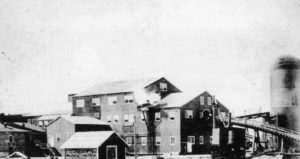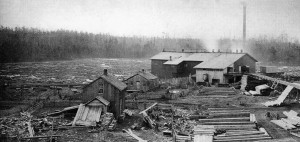The earliest reference to South Manistique or “South-town” is from the early 1880’s. The town was developed around the Hall and Buell Lumber Company Mill. The following description of Southtown is from Earnest Williams: “Several houses in the town had four feet high fences around them to prevent the sand beach from blowing into the yards. All the streets were sand and grass was basically nonexistent.”
Hall and Buell lad lumber rights around Southtown and on Indian Lake. They cut the timber and floated it across Indian Lake to a “pull up” between Sunset and Harrison Beaches. From there it was loaded onto their own railroad and brought to the Southtown mill (The railroad crossed old U.S. 2 near the current location of WTIQ and the gas pipeline).
The Hall and Buell mill was much more progressive than the Chicago and Weston lumber companies’ mills. They utilized a band saw which had a thinner blade than the gang saw and therefore sawed timber at a faster rate. Hall and Buell built docks in Lake Michigan for shipping and dammed the “Southtown creek for a log pond.
Population estimated vary from 300 to 1,000 residents in Southtown’s heyday. The town ended up being short lived, and the official post office (A.C. Hubbell was postmaster) was closed in 1905, with all mail being sent to Manistique. Southtown was short-lived because the Hall and Buell Lumber Company had stumpage on Indian Lake and around town. Once this was cut and made into lumber, there was no more timber to be found, since the Chicago and Weston lumber companies owned the rest of Schoolcraft County.
Basically, there is nothing much left to identify Southtown but a log pond, some hollows where basements were, and in some areas the old railroad grade. Most of the houses were moved into the Manistique area, and when the Nahma sawmill burned, the Hall and Buell mill was bought, dismantled and moved to Nahma. South Manistique is approximately two miles from the city limits going towards Thompson on U.S. 2. The town was situated between two creeks, one of which is called Southtown Creek.
Meanwhile, when the Chicago and Weston Lumber companies were developing Manistique, there were several other lumbering activities going on in the county. The first area is Jamestown, or the Jamestown slough. A lumber mill was built at Jamestown by Ebenezer James, Constant M. Ruggles, James R. Slawson, Eric McArthur and Dougold McMillan. These men all had lumber holdings north of Thunder Lake. They cut the timber and sent it down Kilpecker Creek into Thunder Lake to Murphy Creek and then the Indian River.
From the Indian River the logs were rafted to Jamestown. The lumber from the mill was then transported to the Manistique docks on a horse-drawn railroad which ran on two-by-fours. The route of this railroad ran from River Road to Jamestown and then onto Maple Street to the docks (probably the same route as the Tannery Road). The Jamestown Mill ran from 1875 to 1880, when they sold their remaining standing timber to the Chicago Lumber Company.
Most of the men who worked for the Jamestown Mill lived in the area by the mill and the old slough. The men continued to live in the area called the Tannery Road and River Road, but were then able to work for the Chicago Lumber Company. Murdock McNeil and Ed Cookson were with the Jamestown operation from its beginnings and went to work for the Chicago Lumber Company.
Ed Cookson started driving his team of horses hauling timber, became a camp foreman and eventually was a walking boss in charge of all Chicago Lumber Company’s woods operations. Paddy Miles, who drove the horses pulling the tram cars to the docks, worked originally as a policeman and later was a camp foreman for the Chicago Lumber Company.


